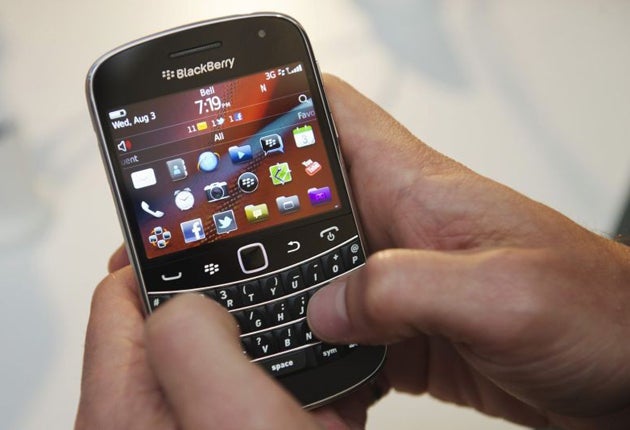The medium is the message
Was the use of BlackBerry Messenger by rioters this week a surprise? Samuel Muston breaks down the demographics of how we communicate today

In the moments before he was shot by police in a minicab in Tottenham last Thursday, Mark Duggan sent a message to his girlfriend, Semone Wilson. "The feds are following me," he wrote.
But instead of sending a text message, he chose to use his phone's free, chat-messaging service, BlackBerry Messenger (BBM).
It was this same medium that – as has been widely reported this week – brought protesters together outside Tottenham Police Station on Saturday afternoon. And in the days that followed it was used by rioters to plan where to congregate ahead of trouble in boroughs across London.
"Everyone in Edmonton Enfield Wood Green everywhere in north link up at Enfield Town station at 4 o'clock sharp," was one message passed around by BBM users in north London on Sunday.
So why has the mobile of the City professional become the communication device of choice for British teenagers? And which communication devices are being used by other demographics? And why?
BLACKBERRY
BlackBerrys were the mid-Noughties phone of choice for high-flying businessmen and politicos, because they were one of the first handsets that would allow users easy, reliable email on the go.
Fast forward to 2011 and the demographic has changed dramatically. According to a recent ICM report, the archetypal BlackBerry user is now between 18 and 24-years-old and earns between £15,000 and £30,000.
"The change can be put down to two things," says Patrik Kärrberg of the LSE's communication group, "Firstly, an increasing awareness that the BBM service is free, instantaneous and largely untraceable when you have other users' BBM pins. And, secondly, the handsets price points. You can get a phone free on a £10 to 20 contract or buy a basic Blackberry handset for £100 – so it's well within the reach of lots of teenagers."
PAY PHONES
Once the primary way to make calls when on the move, the British public has dramatically fallen out of love with the pay phone.
With more mobile phones in use in the UK than people – some 70 million handsets, which are used by 91 per cent of the population – the familiar red boxes (or more likely glass boxes) are largely unused and often in a state of grotty disrepair.
As far back as 2003, BT reported that 70 per cent of its boxes lost money and several thousand had already been removed from operation. Their lowly status now sees them primarily portrayed as devices for criminals in TV shows like The Wire – not least because they can't be tapped.
VIBER
Like Skype, Viber is part of the Voip (voice over internet protocol) family of technologies. These allow users to make free calls using the internet, rather than a phone line. But where Skype is intended for use on a home computer, Viber is a smartphone application that can be downloaded free.
The application functions anywhere in the world where there is a Wi-Fi connection. And its flexible, cost-free format has seen it become popular for travellers who use it to avoid expensive long-distance phone charges when calling back home.
APPLE iMESSAGE
Apple has announced that it is to launch its own version of the BlackBerry instant-messaging service to be bundled with its iOS 5 mobile operating system, due out sometime this autumn. The iMessage service will include text messages, photos, video, contact and group messaging and has been likened to Facebook chat or a souped-up version of Apple's existing iChat facility.
It will be supported via 3G and Wi-Fi and will be synced across all of Apple's devices, so users can have cross-platform conversations.
The micro-blogging service has frequently been described as a mouthpiece and barometer of middle-class, liberal opinion. A place where news is relayed, restaurant tips are swapped and witty – and not so witty – asides are broadcast to followers.
That said, it has also been put to more serious uses. After the Iranian elections in 2009, protesters used it as a tool to marshal supporters and spread news of the Tehran government's civil-rights crackdown. It was also the epicentre of the London clean-up movement, in which users coordinated post-riot repairs this week.
Its restrictive 140-character form and its declarative, rather than conversational, nature has seen it attract users who typically have a university education (76 per cent of users), are aged 26 to 34-years-old and earn between £26,000 and £52,000, according to the tech specialist Digital Surgeons.
LANDLINES
"If a conversation's worth having, use your landline," ran the strapline of a BT advert from 2009. The message would have seemed obtuse 15 years earlier – but with the rise of the mobile phone and more people living in rented accommodation, fewer and fewer people choose to make the commitment and pay for the luxury of a phone on the hall table or kitchen wall.
Although still the primary means of voice communication in the business world, the percentage of domestic users with a mobile but no landline has grown in recent years. Around 15 per cent of UK households now fall into that group, up from 2 per cent in 2006. Further falls are expected in coming years.
Join our commenting forum
Join thought-provoking conversations, follow other Independent readers and see their replies
Comments
Bookmark popover
Removed from bookmarks